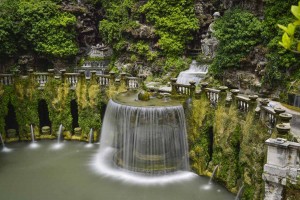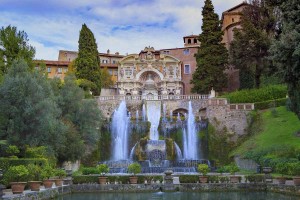
©Bigstock.com/itsajoop
When it comes to the Renaissance period, you’re probably thinking of architectural masterpieces, the rediscovery of ancient Greek and Roman ideals mixed with contemporary knowledge of the 15th and 16th century. Actually, the Renaissance revolutionised far more areas including the art of garden design. The classic Italian garden, usually designed and created with a villa, experienced a massive boom. Only few other sites are as grand and diverse as Villa d’Este in Tivoli near Rome. Both the villa and the garden were declared UNESCO World Heritage Site in 2001, but an important election in the 16th century almost prevented its construction.
From papal candidate to master of garden design
Cardinal Ippolito II d’Este was the French candidate in several conclaves including the marathon election of 1549 and 1550 that eventually gave way to Pope Julius III. Becoming Governor of Tivoli, Ippolito had a former Benedictine monastery converted into a palace starting in 1550. An idea to lay out a garden on the steep hill below the monumental building was developed rather quickly, but it took another ten years until its implementation. Pirro Ligorio, a painter and architect from Naples, created the splendid draft, court architect Alberto Galvani took care of radically reshaping the entire valley.
Works were almost complete when Ippolito died in 1572. The project, however, was everything but finished. His successor Cardinal Alessandro d’Este prompted substantial alterations to the garden concept, renewed the buildings and fountains. The site noticeably deteriorated in later years under Habsburg ownership. It wasn’t until 1851 when Gustav-Adolf Prinz zu Hohenlohe-Schillingfürst had this magnificent estate revived and renewed completely. Composer Franz Liszt would become a regular and gave one of his final concerts here in 1879. Villa d’Este was once again restored elaborately after bomb damages in the Second World War. Maintenance works have been taking place almost continuously ever since. Don’t be surprised if you see some hoardings and barriers during your visit.
The villa

©Bigstock.com/khunaspix
Before focusing on the amazing gardens, we take a look at the villa itself, skipped and overlooked far too often. Today’s entrance next to Santa Maria Maggiore was hardly used during Ippolito’s time. Instead, guests and visitors would walk up the garden stair by stair making them visible from afar. Passing the foyer with Old Testament depictions and a hall with scenes from the life of King Solomon, you reach the wide courtyard with the neat Fountain of Venus. After the salon, where Ippolito would receive people, you enter the cardinal’s apartments. His bedroom offers a particularly gorgeous view of the entire garden. Ambling through the ground floor, you cross countless lavishly decorated halls. Mosaics and wall paintings by famous Renaissance artists adorn these stunning, pompous rooms. Each hall has its very own theme, such as ancient Greece, certain characters from the Bible or hunting scenes.
The gardens
Time to get to the main attraction, and what an attraction it is. More than 500 fountains, nymphs, grottos and water attractions are spread throughout the gardens of Villa d’Este. They utilise the slope perfectly embedding all of that and much more fascinatingly into the two main parts. The comparatively flat main garden supposedly even had two labyrinths in the 16th century. It now comprises of several smaller gardens connected by access balconies. Multiple ramps, terraces and stairs run through the hill garden making the valley slope accessible through an alcove corridor with far-stretching crosscuts along the fountains. There’s another impressive cross axis path with three fishponds, astonishing views and even more highly exciting terraces below all of that.
The fountains
Countless fountains line the imposing gardens. There’s an almost unbelievable mass of garden design for you to discover ranging from Cento Fontane, a collection of one hundred fountains along one single alley, to various fountains with animal depictions, historical, mythical and religious pieces. We’ve prepared a selection of our favourites for you.
- Fontana dell’Organo: The organ fountain is among the most famous fountains of its kind and was replicated multiple times throughout Europe. Being the first water organ ever, it amazed guests creating giddy excitement. The delicate mechanics were restored over the course of many years and only became operational again in 2003. From its monumental architecture to the countless little details and hidden statues, the water organ will most definitely enchant you as well.
- Fontana di Proserpina: Statues of four Roman Emperors – Julius Caesar, Augustus, Trajan and Hadrian – were originally supposed to line this small, neat fountain. The triumphal arch with twisting columns distantly similar to those of St. Peter’s Cathedral in Rome are evidence of this idea. Unfortunately, the statue of the namesake Proserpina was lost to the trials of time.
- Fontana della Civetta: The rather formulaic design of the owl fountain utilises distinct symbolism. Diligently arranged mosaic decorations, numerous smaller figurines and the Este coat of arms held aloft by two angels give the Fontana a representative look. The birdsong-producing mechanism was only reconstructed and installed in recent years.
- Fontana dell’Ovato: This oval installation was one of the first fountains to be completed. Pirro Ligorio’s water theatre draft was given an artificial mountain. People would meet in the appertaining Grotto of Venus hoping to see hot summer days pass by quicker.
- Fontana dei Draghi: Ligorio was inspired by the Hercules myth for his dragon fountain. The statues depict the picking of the golden apples from the Garden of the Hesperides. Ladon, the apple-guarding dragon, is sort of the leading character of the Fontana dei Draghi. By the way, you can find even more depictions of Ladon and Hercules inside the villa with its countless frescoes.
- Fontana di Rometta: A miniature model of ancient Rome in the shape of a fountain marks one of the most important places in the garden. Fontana di Rometta symbolises the course of the Tiber River from its spring in the Apennine Mountains to providing water supply to the city. The artificial mountain was added later.
- Fontana di Nettuno: The newest fountain of Villa d’Este was only created in the 20th century to replace a deteriorated rock waterfall. Attilio Rossi turned the remains into this particularly imposing fountain with tall waterspouts around 1930. He recycled a statue of Neptune, originally intended for a different, unfinished fountain, as the centrepiece of the Fontana di Nettuno.
- Cento Fontane: An alley with hundred smaller fountains, Cento Fontane, runs between Fontana dell’Ovato and Fontana di Rometta. Even though the once rich decorations have since deteriorated or been overgrown by lush green, you can still neatly see the various rock masks and water terraces that line the way of what likely is the garden’s most beautiful walk.
If you’re happy to walk quite a bit, Villa d’Este with its breathtakingly beautiful gardens is always worth a visit. It is an excellent destination during your city holiday in Rome, being less than an hour east of the Italian capital. Let yourself be enchanted by this Renaissance masterpiece – a genuine experience both inside and outside.